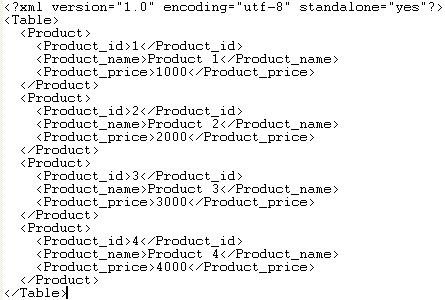XML and VB.net
By: Issac in VB.net Tutorials on 2009-02-21
XML - Extended Markup Language, which is a subset of SGML (Standard Generalized Markup Language) is a tag based language which is very apt in handling data across applications, also it is a platform independent language that is, information formatted in XML can be used in various Operating Systems, also it is a self describing language so it provides the data and rules which can be used to identify the information it contains.
XML files are made up of tags that contain data. Generally a start tag and end tag to hold the data. For example, if you want to create an XML tag name "Header", the start tag is like < Header > and the end tag is like < /Header >. We can fill our information between these tags.
< Header > Header Content Here < /Header >
here are some important points to remember while creating an XML file
* XML is case sensitive
ex: < Header > is not same as < HeadeR > .
* Tags must be closed in the reverse order that they were opened
ex : < first-tag >< second-tag > Data here < /second-tag > < /first-tag >
Sample XML File

The .Net technology is widely supported XML file format. The .Net Framework provides the Classes to read, write, and other operations in XML formatted files. These classes are stored in the namespaces like System.Xml, System.Xml.Schema, System.Xml.Serialization, System.Xml.XPath, System.Xml.Xsl etc. The Dataset in ADO.NET uses XML as its internal storage format.You can use any text editor to create an XML file.
Add Comment
This policy contains information about your privacy. By posting, you are declaring that you understand this policy:
- Your name, rating, website address, town, country, state and comment will be publicly displayed if entered.
- Aside from the data entered into these form fields, other stored data about your comment will include:
- Your IP address (not displayed)
- The time/date of your submission (displayed)
- Your email address will not be shared. It is collected for only two reasons:
- Administrative purposes, should a need to contact you arise.
- To inform you of new comments, should you subscribe to receive notifications.
- A cookie may be set on your computer. This is used to remember your inputs. It will expire by itself.
This policy is subject to change at any time and without notice.
These terms and conditions contain rules about posting comments. By submitting a comment, you are declaring that you agree with these rules:
- Although the administrator will attempt to moderate comments, it is impossible for every comment to have been moderated at any given time.
- You acknowledge that all comments express the views and opinions of the original author and not those of the administrator.
- You agree not to post any material which is knowingly false, obscene, hateful, threatening, harassing or invasive of a person's privacy.
- The administrator has the right to edit, move or remove any comment for any reason and without notice.
Failure to comply with these rules may result in being banned from submitting further comments.
These terms and conditions are subject to change at any time and without notice.
- Data Science
- Android
- React Native
- AJAX
- ASP.net
- C
- C++
- C#
- Cocoa
- Cloud Computing
- HTML5
- Java
- Javascript
- JSF
- JSP
- J2ME
- Java Beans
- EJB
- JDBC
- Linux
- Mac OS X
- iPhone
- MySQL
- Office 365
- Perl
- PHP
- Python
- Ruby
- VB.net
- Hibernate
- Struts
- SAP
- Trends
- Tech Reviews
- WebServices
- XML
- Certification
- Interview
categories
Related Tutorials
Changes in Controls from VB6 to VB.net
Unstructured Exception Handling in VB.net
Structured Exception Handling in VB.net
Creating Sub Procedures in VB.net
Passing a Variable Number of Arguments to Procedures in VB.net
Specifying Optional Arguments with default values in Procedures in VB.net
Preserving a Variable's Values between Procedure Calls in VB.net
Throwing an Exception in VB.net
Comments